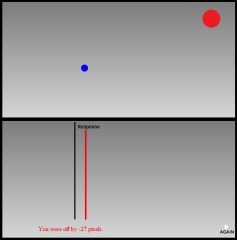 El efecto «flash lag» es una ilusión óptica que demuestra la dificultad de percepción en la detección con precisión de la posición de un objeto en el momento que sucede otro evento. El truco es estimar/recordar la posición del círculo azul en el momento que el círculo rojo parpadea (claro que puede ser mejorado con la práctica). Si eres un escéptico benigno (y espero que lo seas), puedes filmar la pantalla con una cámara normal (30 fps es suficiente) para verificar la posición real del círculo azul en el momento del flash que es demarcado por una línea roja.
El efecto «flash lag» es una ilusión óptica que demuestra la dificultad de percepción en la detección con precisión de la posición de un objeto en el momento que sucede otro evento. El truco es estimar/recordar la posición del círculo azul en el momento que el círculo rojo parpadea (claro que puede ser mejorado con la práctica). Si eres un escéptico benigno (y espero que lo seas), puedes filmar la pantalla con una cámara normal (30 fps es suficiente) para verificar la posición real del círculo azul en el momento del flash que es demarcado por una línea roja.
En contraste con muchas ilusiones ópticas, ésta puede tener consecuencias catastróficas en el mundo real, que de hecho afectan el destino de naciones enteras. Me refiero al fútbol, por supuesto. Se estima que los árbitros asistentes de la FIFA, llaman erróneamente fuera de lugar el 24% del tiempo. Este error es causado por la tendencia del sistema visual de percibir un objeto (en el caso del fuera de juego: cuando el delantero recibe el balón), en el momento de otro evento (el momento del pase), por delante de la que es la posición verdadera.
Para ir al experimento haz click aqui.
The flash lag effect is an illusion that demonstrates the perceptual difficulty in accurately detecting the position of an object at the time of another event. You should find that you generally estimate the position of the blue circle, ahead of its actual position at the time the red circle flashes (although this can be compensated for with practice). If you are a benign skeptic (and I hope you are), you might want to film the screen as you do the task (a 30fps digital camera movie will do) to verify the real position of the blue circle at the time of the flash is indeed at the red line.
In contrast to many illusions, this one may have catastrophic real-world consequences, and indeed affect the fate of entire nations. I’m referring to soccer, of course. It is estimated that FIFA assistant referees incorrectly call offsides 24% of the time. This error has been proposed to be caused by the the visual system’s tendency to perceive an object (in the offside call case: the moving and most forward receiver) at the time of another event (in this case the pass), ahead of it’s true position
